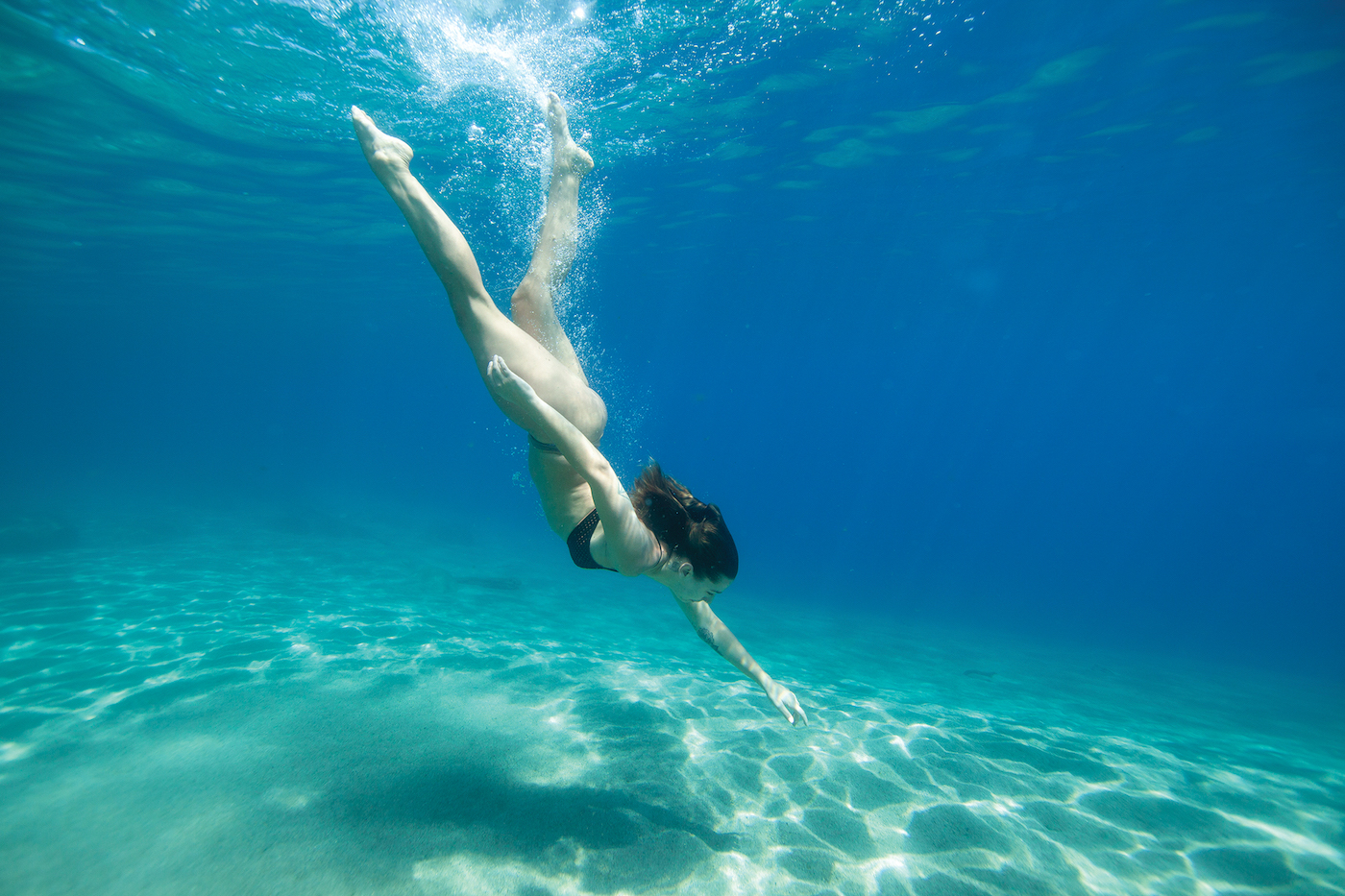
25 Jun A Deep Dive into the Hazards and Allure of Lake Tahoe
Outside of its beauty, the cold water of North America’s largest alpine lake presents inherent dangers that should not be underestimated
Labor Day 2020, I stood on a dock on Lake Tahoe’s North Shore and gazed across the choppy surface through ominously smoky skies. At the tail end of a long, hot summer, the water temperature hovered around 68 degrees, which is, by all accounts, warm for Lake Tahoe. I slapped my swim cap over my head, tucked my hair underneath, pressed my goggles tight around my eyes and dove in headfirst.
With each stroke, I found my mind drifting farther from the task at hand, focused instead on the slew of drownings that had recently occurred on Tahoe—a thought pattern that had become part of my morning swim routine. One incident in particular continued to haunt me.
On August 10, Ryan Normoyle, a 29-year-old woodworker from New Jersey, set up his phone to record himself doing a backflip off his rental boat. Unaware that he had left the boat in gear, Normoyle is seen in the clip for a brief period after resurfacing, watching in panic as his boat steadily coasts away. His body was recovered over a month later at a depth of more than 1,500 feet, making it the deepest recovery ever in Lake Tahoe.
While this heart-rending story is unique in terms of accidents at Tahoe, the tragic outcome has become an all-too-common occurrence on North America’s largest alpine lake. In fact, rescue personnel were pushed to their limits with a record number of distress calls and searches last summer, when the Tahoe Basin was inundated with visitors as pandemic restrictions eased. By summer’s end, 15 lives had been lost on Lake Tahoe.
The primary culprit, ironically, was perhaps Tahoe’s most celebrated feature: Its crystal-clear—but deceptively cold—water.
“Cold-water shock, cold-water emersion, hypothermia, those dangers have always been here at Lake Tahoe, but it’s something that is now being brought to the forefront of our outreach,” says Deputy Ron Skibinski with the Douglas County Sheriff’s Office. “The question on our hands now is, how do we educate people about this? How do we get the word out to try to prevent these tragedies from happening?”
As I continued my swim, questions swirled in my head. How do so many people succumb to Tahoe’s cold water? Is it a lack of swimming experience? Or could these fatalities be chalked up to bad luck? And what about the countless people who swim in the lake every day in the summer without falling victim to its inherent dangers? Not to mention, the long-distance swimmers and polar-plunge fanatics who, against all logic, seem to thrive in cold water?
Ultimately, there is no definitive answer to any one of these questions. But, as Tahoe’s emergency personnel will attest, knowledge and good decision-making are crucial elements to safely recreating on The Jewel of the Sierra.
“You can’t let your guard down on Lake Tahoe,” says Thomas Bowles, executive petty officer with the U.S. Coast Guard Station in Tahoe City. “Just because it’s a family vacation and you’re here to let go and enjoy yourself, the dangers are still here, and they’re very real.”
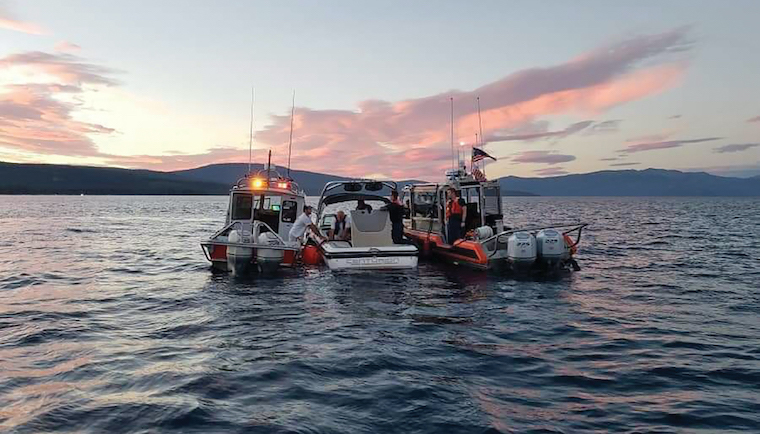
Rescue personnel respond to an incident in which a boat was taking on water, photo courtesy TowBoatU.S. Lake Tahoe
Help on the Water
With 72 miles of shoreline, Lake Tahoe is straddled by two states and divided into five counties, with multiple agencies that govern their own territories, as well as collaborate on a case-by-case basis. The result is a highly efficient and extensive search-and-rescue force on Lake Tahoe—and one that is called upon often.

A battered boat on Tahoe’s East Shore illustrates the dangers of high-wind events, photo courtesy TowBoatU.S. Lake Tahoe
But these agencies have never seen anything like the summer of 2020.
Fueled by the COVID-19 pandemic, which drove people out of their locked-down cities and into the Sierra en masse, Tahoe’s emergency responders saw a substantial surge in incidents on the water. In late August, the Coast Guard reported an 85 percent increase in distress calls on the lake compared to the previous summer. By summer’s end, some 96 search-and-rescue operations were executed on the California side of the lake and 32 accidents were reported. Fifteen of those proved fatal, including 12 by drowning.
While the rise in accidents can be traced directly to the influx of people enjoying the lake, the stats were concerning nonetheless for rescuers, who have ramped up efforts in recent years to educate the recreating public.
“Tahoe is deceptive in so many ways, and the smaller decisions people make can either have a good outcome, or they can have tragic results,” says Tahoe Douglas Fire Marshal Eric Guevin, who works aboard the Marine 24 rescue boat. “We don’t want people to fear the lake, but we do want them to respect it, and the more information we’re able to share with people about the risks of swimming in this lake, the better chance we have at saving lives.”
Yet, dangers exist on Tahoe even for those with no intention of swimming. Strong, shifting wind patterns often whip up ocean-like swells in a matter of minutes, which can threaten boaters who are caught off-guard by the conditions.
“If there are 6-foot waves and they’re 3 feet apart, that’s where things get dangerous for small vessels and they start taking on water, or someone falls overboard and now you’re dealing with the problems associated with cold-water shock and hypothermia,” says Skibinski. “We see those kinds of conditions all the time up here.”
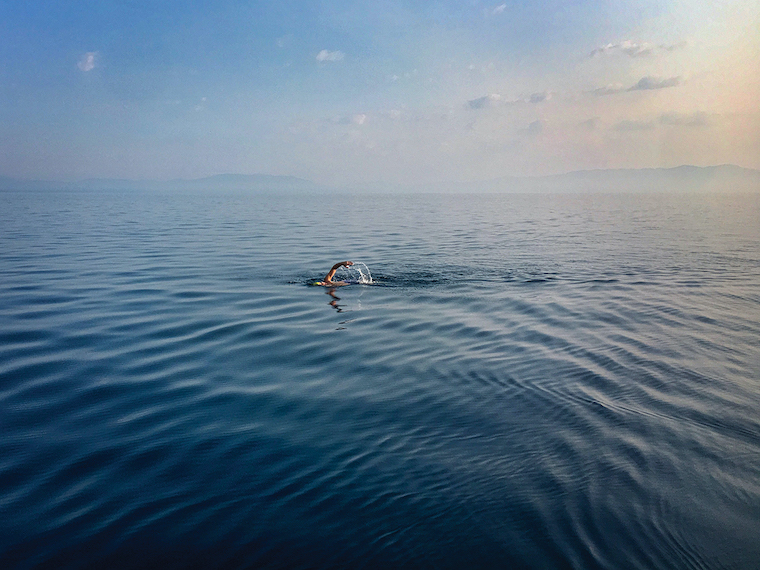
Open-water marathon swimmer Scott Kaloust endures the cold water of Lake Tahoe, sans wetsuit, during his 10.6-mile Vikingsholm crossing, photo courtesy SwimTahoe.com / Pacific Open Water Swim Co.
Shockingly Cold
Fed by snowmelt, Lake Tahoe is a cold body of water relative to most lakes. The average annual temperature is 52 degrees, while the surface can measure up to 70 degrees in the heat of summer and as low as 42 degrees in the winter. By comparison, the San Francisco Bay wavers between the low-50s to mid-60s year-round.
For those who are not acclimated to the water temperature and/or not mentally prepared to take the plunge into the lake, the body’s natural response is often an uncontrollable gasp for air, followed by intense hyperventilation. Attempting just one breath while submerged in water is all it takes to drown, and once someone drowns in Lake Tahoe, it’s unlikely their body will ever resurface on its own.
“Think about it like this, if you get in a hot shower and all of the sudden it turns cold, you immediately gasp for air, right? It’s the same thing when you jump in the lake,” Skibinski explains. “If people aren’t exposed to it ahead of time or don’t know what to expect and they jump in and hit a thermocline, or say it’s early in the season and the water is still in the low 50s, their brain automatically wants to take a breath as soon as they hit the water.
“If they do manage to resurface, they’re already drowning by the time they reach the top of the water, and before anyone else realizes it, it’s too late—they’ve already gone back down.”
Of the three critical phases of cold-water immersion, shock differs from incapacitation and hypothermia in that it happens immediately upon immersion, while incapacitation—or loss of movement—and hypothermia can take 10 minutes or more to set in. This window gives rescuers crucial time to reach someone in need of help in the icy water, but sometimes that help comes too late.
“This lake is no joke,” Skibinski says. “I don’t mean to sound blunt, but this lake can kill you. It doesn’t care. It will eat you up.”

Kate Rye, a former standout swimmer at Incline High School, takes on the nearly 22-mile length of Lake Tahoe in August 2020, courtesy photo
Surviving the Chill
As far as open-water swimming goes, I’m a novice at best. When I swim in Lake Tahoe, I prefer to leisurely hug the shoreline for roughly 45 minutes to an hour at a time—child’s play in the world of marathon swimmers. That said, I’ve been swimming in Lake Tahoe for 14 years, and although I’ve certainly felt symptoms associated with cold-water shock, the chilly water has never been a deterrent.
With the many drowning incidents that have pervaded my thoughts during my morning swims, however, I began to wonder: If I wound up in the middle of the lake under circumstances beyond my control, would I be able to make it to shore? I’d like to believe so. But there’s no way to be sure. Should that scenario ever play out in reality, I sought the kind of advice and knowledge that Tahoe’s rescue personnel encourage.
What better source than someone who swam the nearly 22-mile length of Tahoe last summer?
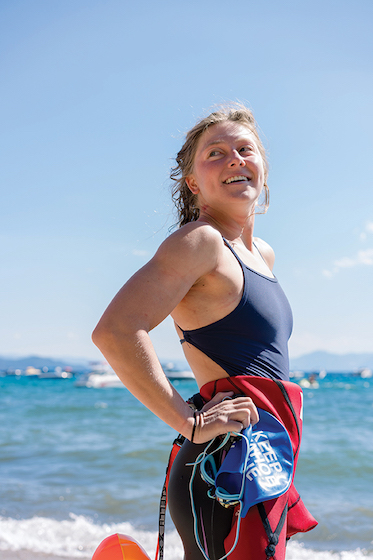
As an experienced swimmer who is accustomed to the chilly temperature of Tahoe, Rye says the mental challenges of cold-water swimming outweigh the physical, courtesy photo
Kate Rye, an Incline Village native and undergraduate student at University of Nevada, Reno, achieved the ambitious feat on August 11, 2020, covering the distance in just under 11 hours. Rye says enduring the cold for an extended time is as much a mental endeavor as a physical one—if not more—and is something that even the most experienced open-water swimmers must overcome.
“Even if you grew up a lifelong competitive swimmer and you know you have the physical strength to keep swimming, you still have to get through it mentally, and that’s the biggest challenge,” Rye says. “There are times when even the best open-water swimmers panic, especially when the cold starts to set in, and if you can’t calm yourself down, your mind will get the best of you.”
Part of strengthening her mental perseverance during her Tahoe crossing stemmed from the precautionary steps Rye had set in place. On the day of her swim, she was equipped with a bright orange swim buoy for visibility and donned a wetsuit to stay warm. She alerted the Coast Guard before entering the water, enlisted friends to boat and kayak alongside her for support, and stuck to her plan to hydrate and refuel every 30 minutes.
But for the inexperienced swimmer, or someone who ends up in Lake Tahoe unintentionally, simply knowing what to do upon submersion is important.
“If you’re not necessarily the strongest swimmer and you’ve accidentally fallen into the lake, the first thing you need to do is focus on calming yourself down,” says Rye, recommending measures such as floating on your back to conserve energy—and keeping your head above the surface. “The last thing you want to do is start panicking and flailing around because it will use up all of your energy, and you’re going to need all you can get to make it to shore alive.”
Once gaining a sense of calm in the event of an emergency, Rye says to assess the situation as quickly as possible to find the fastest exit strategy.
“If you can’t get out of the water safely, you have to get into a safe place in your mind if you’re going to have any chance at surviving,” she says.
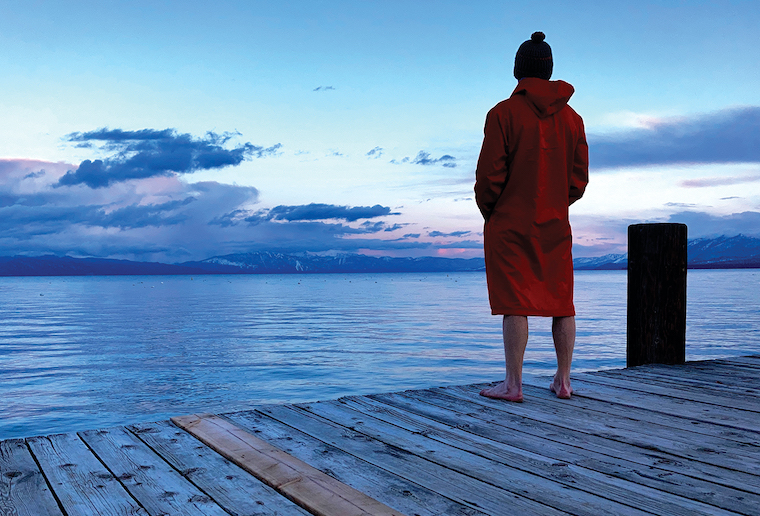
Nicholas Mitchell of Tahoe City prepares for his daily dip in Lake Tahoe, courtesy photo
When Cold Water Warms the Soul
The dangers of cold water are very real. But for some, submerging in frigid water on a regular basis can serve as an effective form of therapy.
Take Nicholas Mitchell, for example. In an effort to calm the madness surrounding the pandemic, the 42-year-old Tahoe City resident has plunged into Lake Tahoe every single day since September 2020—the most bone-chilling days of winter included—and is intent on continuing the routine for an entire year. Like Rye, he says finding the right mindset is most important when dealing with the cold.
“I believe entirely that it’s a mental process much more than a physical one,” Mitchell says. “Over time, my mind has learned that I’ll be fine. I may get cold, but I’ll be fine because I’ve proven to myself, to my mind, that I can handle it.”
Mitchell’s goal to spend approximately three minutes in the lake every day for an entire year will come to fruition this September, but the benefit will extend well beyond his self-imposed deadline. Discovering the rewards has been an ongoing process for Mitchell, who believes it’s improved everything from his mental health and quality of sleep to strengthening his cardiovascular system and relieving aches and pains brought on by pre-existing injuries.
There were, he admits, a handful of stormy days over the winter when the fear of being cold crept in, tempting him to throw in the towel. But his ability to override any reservations was fueled by a sense of euphoria he experienced once he was finally in the water—and, more significantly, by his motivation to create meaning and purpose outside of himself, which he’s found by turning this daily feat into a fundraiser.
With his dips in Lake Tahoe, Mitchell garners support by collecting donations for Cecily’s Fund in honor of Cecily Eastwood, a friend of Mitchell’s who died in a car accident while volunteering in Zambia when she was 19 years old. The money he raises supports education for orphaned Zambian children.
“I started the campaign in the beginning of February when I had finally reached a point where I knew I would be able to do it, and that made it more constructive. It gave me purpose, because now it’s about more than just me being crazy,” Mitchell says.
Based on his experience braving the coldest conditions Tahoe has to offer, Mitchell recommends to anyone who enters the lake by accident to focus on breathing first and foremost.
“It’s the most important thing you can do to stay alive,” he says. “Once you get through the first 30 seconds of shock, you’ll be able to assess your situation more clearly, but not if you can’t breathe.”
Memorial Day 2021, I paid a visit to my favorite dock on Tahoe’s North Shore—the starting point to most of my swims. I knew the water temperature was in the low 50s, and that if I jumped in, it would likely take my breath away. But I did it anyway. Because it’s not about knowing I’ll be breathless. It’s about knowing with complete certainty that I’ll be OK, that my mind knows not to let my fears become my final breath.
Jenny Goldsmith is a North Lake Tahoe-based freelance writer and marketing manager who holds an MFA in creative nonfiction.




Tristan Cayolle
Posted at 17:11h, 19 JulyJenny killed it <3
Madonna Borromeo
Posted at 00:45h, 25 SeptemberI lived on So. Shore for 17 years. I wasn’t a water buff in any sense of the word so I never even waded into the water.. But I loved living at the Lake. I was supervisor of housekeeping at Harvey’s hotel then at the Inn, maintaining both after the Bomb destroyed the lower floors of the hotel the in the 60,s a tragic ordeal. Later becoming Executive housekeeper at Tahoe Beach and Ski Club. I got a offer to relocate from the Lake to supervise the building of a hotel across from the New Water Works Park.. After completing that I was tired of management and got a job bartending which I knew nothing about…after three years of the pungent smell of beer and wine I retired from working period, my back and hips were shot out from jobs they weren’t designed to do. So I settled in Shasta Lake Ca. In 1976 where my parents bought their retirement property. When my dad passed I moved in with my momma, and when she passed my daughter moved in with me and so it will go on down the line. I turned 81 this last Dec. and I’m getting a bit tired. I hope she will be ready for the change when time comes, as the Lord hasn’t given me a set date when I’ll be joining Him🙏✝️❤️✝️🙏.